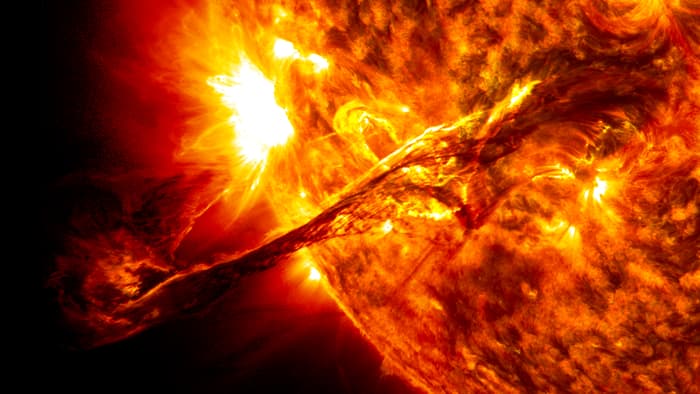Fresh research has revealed that powerful solar storms known as "superflares" are generated via the same process as common solar flares produced by our Sun. These superflares are capable of posing a significant threat to our advanced technology, and seriously harming Earth's protective ozone layer.
Earth's atmosphere is bombarded by charged particles from the Sun on a constant basis. Periodically, our star throws off what is known as a solar flare. Most of the time the only visible effect of these solar storms are stunning aurora that manifest around Earth's higher latitudes. However, one event in mankind's recorded history highlighted the significance of the threat posed by powerful solar activity.
On Sept. 2, 1859, Earth's magnetic field was struck with the first particles cast out by a titanic solar storm that had exploded from our Sun the previous day. The interference caused by the event threw the worldwide telegraph network into disarray, and based on ice core samples retrieved from Greenland, caused significant damage to Earth's protective ozone layer. The powerful storm is now referred to as the Carrington Event.
Should such an eruption occur today, its ability to interfere with our electronics and power supplies would cause a far greater amount of damage owing to our complete reliance on technology in almost every facet of our lives.
Four years ago the Kepler Space Telescope discovered an entirely new breed of solar activity – a class of solar storms known as superflares, that are believed to be on average 10,000 times more powerful than the Carrington Event of 1859.
The vast majority of the 100,000 stars observed to experience the flare events as part of the study boast a magnetic field significantly stronger than our Sun. However, around 10 percent were on a par, or even hosted a magnetic field weaker than that of our star.
The international team of astronomers made use of the Guo Shou Jing telescope located in the Hebei Province, China, in order to ascertain whether the powerful solar storms were generated via the same method as standard solar flares.
Common solar flares manifest themselves when a magnetic field on the surface of a star collapses, releasing vast amounts of magnetic energy and stellar material that goes on to interact with satellite bodies such as our home planet.
The Guo Shou Jing telescope was able to harvest short ultraviolet light emissions from the 100,000 stars involved in the study, in the space of a few weeks. This particular light wavelength allowed the team to observe the changes in the stars' magnetic fields as the superflares occurred. An analysis of the Guo Shou Jing data revealed that the phenomena appeared to be created in via the same process as standard solar flares.
Back on Earth, the team discovered evidence of minor superflare events impacting our planet through an analysis of ancient tree rings. Tree rings dated around the year AD 775 displayed evidence of the radioactive isotope 14C present in our atmosphere. According to the researchers, this isotope formed as a result of cosmic ray particles or protons hitting out atmosphere, emanating from a minor superflare, around 10 – 100 times larger than any solar flare in recorded history.
Based on observations from the Guo Shou Jing telescope, and the terrestrial tree ring study, the team estimates that our Sun would experience one superflare incident per millennium.
A paper on the research has been publishedonline in the journal Nature Communications.
Source: Aarhus University
